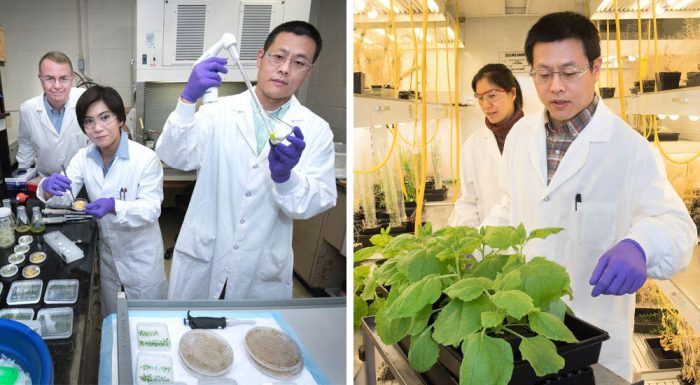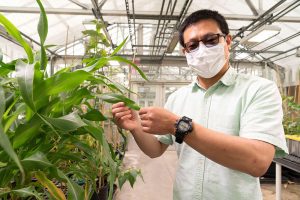BNL’s Zhai scores $2.5 mln early career DOE award to study plant signal

By Daniel Dunaief
In a highly competitive national award process, the Department of Energy provides $2.5 million to promising researchers through Early Career Research Funding.
Recently, the DOE announced that Zhiyang Zhai, an associate biologist at Brookhaven National Laboratory, was one of 83 scientists from around the country to receive this funding.
“Supporting talented researchers early in their career is key to fostering scientific creativity and ingenuity within the national research community,” DOE Office of Science Director Asmeret Asefaw Berhe, said in a statement.
Zhai, who has worked at BNL for 11 years, is studying a signaling protein called Target Of Rapamycin (TOR) kinase, which is important in the plant and animal kingdom.
He hopes to develop a basic understanding of the way this kinase reacts to different conditions, such as the presence of carbon, to trigger reactions in a plant, including producing oils through photosynthesis or making seeds.

“Ancient systems like this evolve in different lineages (like plants and animals) to work differently and [Zhai] wants to find out the details of how it works in plants,” John Shanklin, chair of BNL’s Biology Department, explained in an email.
Zhai is trying to define which upstream signals interact with TOR and what the effects of those interactions are on TOR to learn how the kinase works.
He is hoping to get a clear idea of how different nodes interact and how signaling through carbon, nutrients and sunlight affects TOR kinase levels and its configuration.
Researchers may eventually use the knowledge of upstream regulators to reprogram responses by introducing enzymes that would cause the synthesis, or degradation, of upstream regulatory metabolites, Shanklin suggested.
This could be a way to “tune” the sensor kinase activity to increase the synthesis of storage compounds like oil and starch.
In the bigger picture, this type of research could have implications and applications in basic science that could enhance the production of renewable resources that are part of a net-zero carbon fuel strategy.
The DOE sponsors “basic science programs to discover how plants and other organisms convert and store carbon that will enable a transition towards a net zero carbon economy to reduce the use of fossil fuels,” Shanklin said.
In applying for the award, Zhai paid “tremendous attention” to what the DOE’s mission is in this area, Shanklin said. Zhai picked out a project that, if successful, will directly contribute to some of the goals of the DOE.
Through an understanding of the way TOR kinase works, Zhai hopes to provide more details about metabolism.
Structure and function
Jen Sheen, Professor in the Department of Genetics at the Harvard Medical School, conducted pioneering work on how TOR kinase regulates cell growth in plants in 2013. Since then, TOR has attracted attention from an increasing number of biologists and has become “a hot and rapidly-developing research direction in plant biology,” Zhai explained.
He hopes to study the structure of TOR using BNL’s Laboratory of Biomolecular Structure at the National Synchrotron Lightsource II.
Zhai, who hopes to purify the plant version of TOR, plans to study how upstream signaling molecules interact with and modify the structure of the enzyme.
He will also use the cryo-electron microscope to get a structure. He is looking at molecular changes in TOR in the presence or absence of molecules or compounds that biochemically bind to it.
Through this funded research, Zhai hopes to explain how signals such as carbon supply, nutrients and sunlight regulates cell growth.
Once he’s conducted his studies on TOR, Zhai plans to make mutants of TOR and test them experimentally to see if a new version, which Zhai described as “TOR 2.0,” has the anticipated effects.
Zhai is building on his experience with another regulatory kinase, called SnRK1, which is involved in energy signaling.
“His expertise in defining SnRK1’s mechanism ideally positions him to perform this work,” Shanklin said.
At this point, Zhai is focused on basic science. Other researchers will apply what he learns to the development of plants for commercial use.
A seminal moment and a call home
Zhai described the award as “very significant” for him. He plans to continue with his passionate research to explore the unknown.
He will use the funds to hire new postdoctoral researchers to build up his research team. He also hopes this award gives him increased visibility and an opportunity to add collaborators at BNL and elsewhere.
The funding will support part of Zhai’s salary as well as that of his staff. He will also purchase some new lab instruments and tap into the award to attend conferences and publish papers.
When he learned he had won the award, Zhai called his mother Ruiming, who lives in his native China. “She is so proud of me and immediately spread the good news to my other relatives in China,” Zhai recalled.
When Shanklin spoke with Zhai after the two had learned of the award, he said he had “never seen Zhai look happier.”Shanklin suggested that this is a “seminal moment” in a career that he expects will have other such milestones in the future.
A resident of Mt. Sinai, Zhai lives with his wife Hui Liu, who is a Research Associate in Shanklin’s group specializing in plant transformation, fatty acids and lipidomics analysis.The couple has two sons, nine-year-old Terence and three-year-old Steven.
As for his work, Zhai hopes it has broader implications.
“The knowledge of TOR signaling will provide us [with] tools to achieve hyperaccumulation of lipids in plant vegetative tissues, which is a promising source for renewable energy,” he said.






